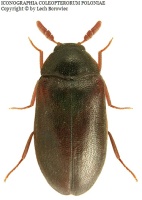
Русские, остановите эту войну! Спасите Свободную Украину!
Russians, stop this war! Save Free Ukraine!
Biodiversity Map
Taxa

Hadrotoma — subordinate taxa:
Taxon count: 2
-
Arthropodaphylum
Click to switch
to select orders
and filters > -
Hexapodasubphylum
Click to switch
to select orders
and filters > -
Insectaclass
Click to switch
to select orders
and filters > -
Coleopteraorder
Click to set
as the main taxon
and as a base
← of the left panel > -
Polyphagasuborder
Click to set
as the main taxon
and as a base
← of the left panel > -
Bostrichiformiaseries
Click to set
as the main taxon
and as a base
← of the left panel > -
Bostrichoideasuperfamily
Click to set
as the main taxon
and as a base
← of the left panel > -
Dermestidaefamily
Click to set
as the main taxon
and as a base
← of the left panel > -
Megatominaesubfamily
Click to set
as the main taxon
and as a base
← of the left panel > -
Megatominitribe
Click to set
as the main taxon
and as a base
← of the left panel > -
Globicornisgenus
Click to set
as the main taxon
and as a base
← of the left panel > -
Hadrotomasubgenus
Click to set
as the main taxon
and as a base
← of the left panel >
PL
YES
name status: valid name
BioMap ID: 1016500
taxon code: 3006
taxonomy checked: YES
Data on distribution in Poland

Statistics
- Records: 79
- Publications: 39
- Collections: 8
- Publication authors: 36
- Illustrations (iconography): 1
- Photos (specimen/observation): lacking
Taxon description
Gatunek rozprzestrzeniony w całej Europie, w Fennoskandii przekraczający koło podbiegunowe, wykazywany też z Kaukazu, Syberii Zachodniej i Kazachstanu. Wszędzie rzadko i sporadycznie spotykany. W Polsce na nizinach i w niższych położeniach górskich występuje prawdopodobnie na całym obszarze, nie jest znany jednak jeszcze z niektórych krain. Bionomia tego gatunku jest słabo zbadana. Pełny cykl rozwojowy jest prawdopodobnie jednoroczny. Postacie dojrzałe są zwykle spotykane od kwietnia do czerwca w próchnie starych drzew, pod odstającą korą, przy wyciekającym soku z pni. Znajdowano je także w zimie pod korą. Zarówno imagines, jak i larwy przezimowują. Larwy występują głównie pod korą, gdzie żywią się szczątkami owadów i pająków oraz wylinkami larw. Przepoczwarczenie następuje pod koniec lata.
Illustrations
... browse
 Globicornis
Globicornisemarginata
External data sources
- Ostatnie rekordy
-
1112909
 ⊡
⊡ Dermestidae: Globicornis emarginata, PL, Nizina Wielkopolsko-Kujawska, Toruń, UTM CD37, 2013, leg. B. Pacuk
Dermestidae: Globicornis emarginata, PL, Nizina Wielkopolsko-Kujawska, Toruń, UTM CD37, 2013, leg. B. Pacuk -
1085125
 ⊡
⊡ Dermestidae: Globicornis emarginata, PL, Podlasie, Nizina Podlaska, podlaskie, wysokomazowiecki, Sokoły, Jeńki, UTM FD27, 2018, leg. A. Lasoń
Dermestidae: Globicornis emarginata, PL, Podlasie, Nizina Podlaska, podlaskie, wysokomazowiecki, Sokoły, Jeńki, UTM FD27, 2018, leg. A. Lasoń -
739698
 ×
× Dermestidae: Globicornis emarginata, PL (Ruta et al. 2011d)
Dermestidae: Globicornis emarginata, PL (Ruta et al. 2011d) -
739626
 ×
× Dermestidae: Globicornis emarginata, PL (Ruta et al. 2006a)
Dermestidae: Globicornis emarginata, PL (Ruta et al. 2006a) -
738947
 ×
× Dermestidae: Globicornis emarginata, PL (Miłkowski et Ruta 2008)
Dermestidae: Globicornis emarginata, PL (Miłkowski et Ruta 2008) -
720150
 ⊡
⊡ Dermestidae: Globicornis emarginata, PL, Pojezierze Pomorskie, Puławy, UTM XA00, 1907, coll. IOR
Dermestidae: Globicornis emarginata, PL, Pojezierze Pomorskie, Puławy, UTM XA00, 1907, coll. IOR -
683929
 ×
× Dermestidae: Globicornis emarginata, PL, Góry Świętokrzyskie, nadl. Łagów, leśn. Trzemosna, 2006, leg. A. Byk (Byk 2007)
Dermestidae: Globicornis emarginata, PL, Góry Świętokrzyskie, nadl. Łagów, leśn. Trzemosna, 2006, leg. A. Byk (Byk 2007) -
683928
 ×
× Dermestidae: Globicornis emarginata, PL, Góry Świętokrzyskie, nadl. Łagów, leśn. Trzemosna, 2006, leg. A. Byk (Byk 2007)
Dermestidae: Globicornis emarginata, PL, Góry Świętokrzyskie, nadl. Łagów, leśn. Trzemosna, 2006, leg. A. Byk (Byk 2007) -
683501
 ⊡
⊡ Dermestidae: Globicornis emarginata, PL, Wyżyna Małopolska, nadl. Łagów, leśn. Cisów, UTM DB92, 2006, leg. A. Byk (Byk 2007)
Dermestidae: Globicornis emarginata, PL, Wyżyna Małopolska, nadl. Łagów, leśn. Cisów, UTM DB92, 2006, leg. A. Byk (Byk 2007) -
568129
 ⊡
⊡ Dermestidae: Globicornis emarginata, PL, Nizina Wielkopolsko-Kujawska, Jabłonna, UTM WT88, 1893, leg. W. Mączyński, coll. Muz. Górnośląskie, Bytom: Mączyński (Mroczkowski 1955(1953))
Dermestidae: Globicornis emarginata, PL, Nizina Wielkopolsko-Kujawska, Jabłonna, UTM WT88, 1893, leg. W. Mączyński, coll. Muz. Górnośląskie, Bytom: Mączyński (Mroczkowski 1955(1953)) - ... more
- Powiązane publikacje
-
Plewa R., Jaworski T., Hilszczański J., Horák J. 2017a. Investigating the biodiversity of the forest strata: The importance of vertical stratification to the activity and development of saproxylic beetles in managed temperate deciduous forests. For. Ecol. Manage., 402:186-193.
 Show records
Show records -
Plewa R., Jaworski T., Hilszczański J. 2014b. Martwe drewno a jakościowa i ilościowa struktura chrząszczy (Coleoptera) saproksylicznych w drzewostanach dębowych. Studia i Materiały CEPL w Rogowie, 41(4):279-299.
 Show records
Show records -
Ruta R., Pacuk B., Jałoszyński P. 2011d. Nowe stanowiska rzadko spotykanych Dermestidae (Insecta: Coleoptera) w Polsce. Wiad. Entomol., 30(1):47-53.
 full text
full text Show records
Show records -
Miłkowski M., Ruta R. 2008. Skórnikowate (Coleoptera: Dermestidae) okolic Radomia. Wiad. Entomol., 27(1):9-15.
 full text
full text Show records
Show records -
Byk A. 2007. Waloryzacja lasów Gór Świętokrzyskich na podstawie struktury zgrupowań chrząszczy saproksylicznych. [In:] Borowski J., Mazur S. (Eds.) Waloryzacja ekosystemów leśnych Gór Świętokrzyskich metodą zooindykacyjną. Wydawnictwo SGGW, Warszawa. pp. 57-118.
 Show records
Show records - ... more





